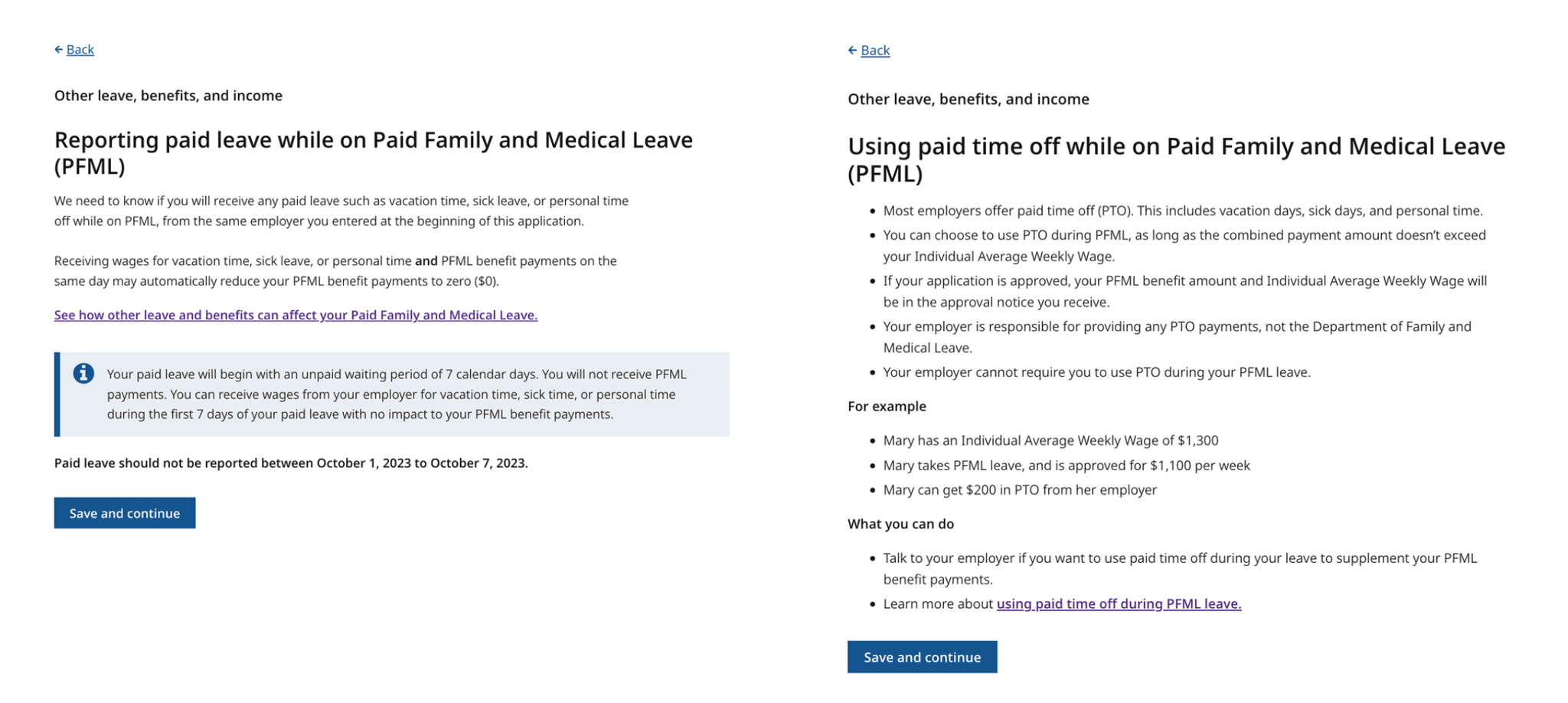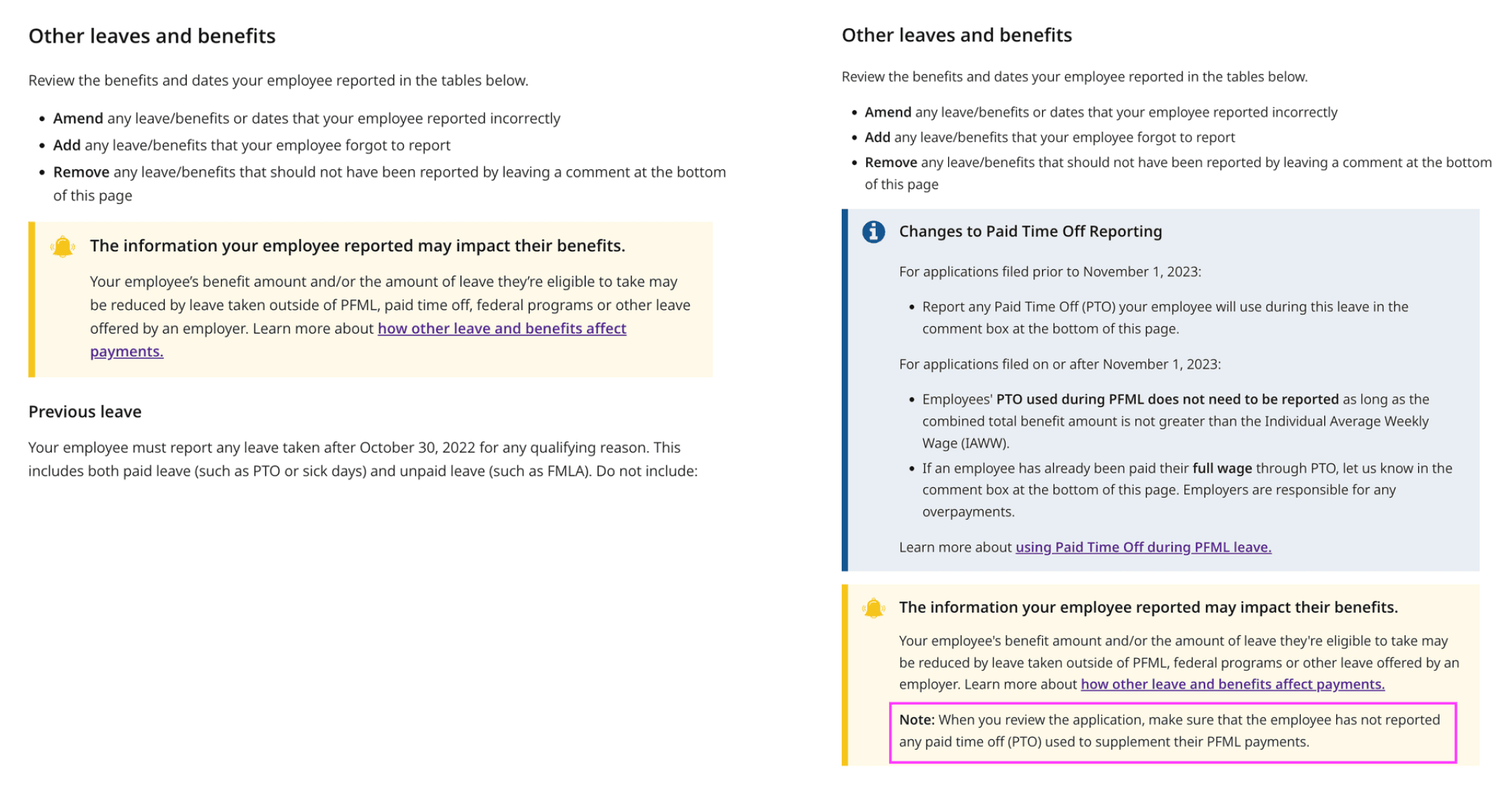Summary
Since 2020, Nava has worked with the Commonwealth of Massachusetts Department of Family and Medical Leave (DFML) to help build and maintain the state’s first-ever paid family and medical leave (PFML) program. Beginning on Nov. 1, 2023, a new policy change enabled workers to “top off” their PFML benefits with employer-provided paid time off (PTO), which includes vacation days, sick days, and personal time. To accommodate this legislative change, DFML tapped Nava to help update the employer and applicant portals — something DFML accomplished in under four months.
Approach
Throughout our work with DFML, the agency has practiced agile methodology — or the process of breaking work into small chunks rather than working toward one big launch. This approach enabled DFML to accommodate the “top-off” policy change while minimizing the disruption of previously planned work. Together with DFML, we reassessed goals and priorities every two weeks, allowing the agency to quickly adapt to new or changing priorities. Within Nava, we dedicated one spike team to helping DFML lead and manage the implementation of the “top-off” changes, allowing our other teams to continue planned work with as little disruption as possible.
Outcomes
In just four months, DFML was able to update the applicant and employer portals to encompass the new “top-off” legislation. We helped DFML amend parts of the application with new questions and messaging about the PTO “top-off” change. DFML also added reminders that workers no longer need to report their employer-sponsored PTO — something they had to do before the policy change — removed obsolete content about reporting PTO, and added information on how to use PTO to supplement PFML benefits.

Before (left) and after (right) screenshots of the “Other Leave, Benefits, and Income” section of the application. Previously, the portal showed applicants content describing what paid time off they should report on the next page. Now, applicants are routed to a page that explains how to use paid time off with PFML benefits.
For the employer portal, we helped DFML add reminders that workers no longer need to report their PTO. We also helped add employer-facing content on how workers can “top off” their benefits.

Before (left) and after (right) screenshots of the employer portal, where employers review applications. We helped DFML update the “Other Leave, Benefits, and Income” section with alerts and reminders about the changes to reporting time off.
After DFML launched the updates, we helped use analytics to monitor how the changes were performing. DFML found that the average time it takes to complete the “Other Leave, Benefits, and Income” section of the PFML application decreased with the portal’s updates.
Process
Previously, workers couldn’t use employer-sponsored time off to supplement PFML benefits. Applicants had to report in their application whether they planned to use any employer-sponsored paid time off during their PFML leave. Receiving PTO wages and PFML benefits on the same day would reduce a worker’s PFML payments to $0.
After the legislative change, workers could “top off” their weekly PFML benefits with PTO up to their Individual Average Weekly Wage (IAWW) — or how much the applicant would make on average in one week. For example, Maria typically earns $900 each week, but receives $640 per week from PFML benefits. If Maria has paid time off from her employer, she can “top off” her weekly benefits with unused PTO that is paid out at her hourly rate. But, she can only receive up to $260 per week from her employer to meet her IAWW.
Now, applicants no longer need to report employer paid time off benefits in their PFML application. Instead, workers just need to notify their employer if they want to supplement PFML benefits with PTO. Employers can use that information to approve a “top off” of a worker’s weekly PFML payments with accrued time off, up to the applicant’s IAWW.
As a result of this, DFML had to make changes to the applicant and employer portals. This work involved all of Nava’s teams on the PFML project—design, engineering, product, and project management. To streamline communication, we decided to develop a spike team composed of one expert from each of our teams.
The spike team focused on communicating our team’s updates and goals to DFML, which enabled us to help DFML complete high level prep work as soon as we learned about the legislation. Meanwhile, our other teams were able to continue in-flight work.
After understanding the scope of the policy change, the spike team helped DFML create and refine user stories that describe the needs and experiences of applicants, employers, and government staff. Creating user stories is a standard part of the agile process and helps ensure that teams account for all use cases and experiences in the final product.
From there, the spike team helped DFML break those needs into actionable tasks and outcomes. The spike team used a ticketing system to triage and assign tasks to other Nava teams every two weeks and coordinated across the teams to ensure there was no duplicative work.
Lastly, the spike team helped DFML coordinate the end user experience for applicants and employers and the final delivery of the portals. This included helping DFML test the portals, coordinate the launch schedule, and monitor and report on the success of the project after the launch.
Conclusion
After learning about the state’s “top-off” policy proposal, DFML had about four months to update the PFML applicant and employer portals. To help DFML accomplish this, we utilized a spike team to streamline communications with state agency staff and to ensure existing work didn’t stop. The applicant and employer portals now reflect the new legislation, enabling workers to easily understand and access the benefits they need.
Written by

Senior product manager

Director of engineering

Editorial associate
